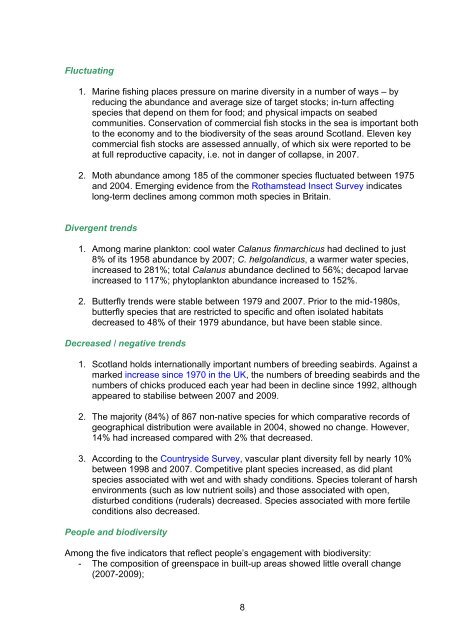Scotland's Wildlife â an assessment of biodiversity in 20
Scotland's Wildlife â an assessment of biodiversity in 20
Scotland's Wildlife â an assessment of biodiversity in 20
Create successful ePaper yourself
Turn your PDF publications into a flip-book with our unique Google optimized e-Paper software.
Fluctuat<strong>in</strong>g<br />
1. Mar<strong>in</strong>e fish<strong>in</strong>g places pressure on mar<strong>in</strong>e diversity <strong>in</strong> a number <strong>of</strong> ways – by<br />
reduc<strong>in</strong>g the abund<strong>an</strong>ce <strong>an</strong>d average size <strong>of</strong> target stocks; <strong>in</strong>-turn affect<strong>in</strong>g<br />
species that depend on them for food; <strong>an</strong>d physical impacts on seabed<br />
communities. Conservation <strong>of</strong> commercial fish stocks <strong>in</strong> the sea is import<strong>an</strong>t both<br />
to the economy <strong>an</strong>d to the <strong>biodiversity</strong> <strong>of</strong> the seas around Scotl<strong>an</strong>d. Eleven key<br />
commercial fish stocks are assessed <strong>an</strong>nually, <strong>of</strong> which six were reported to be<br />
at full reproductive capacity, i.e. not <strong>in</strong> d<strong>an</strong>ger <strong>of</strong> collapse, <strong>in</strong> <strong>20</strong>07.<br />
2. Moth abund<strong>an</strong>ce among 185 <strong>of</strong> the commoner species fluctuated between 1975<br />
<strong>an</strong>d <strong>20</strong>04. Emerg<strong>in</strong>g evidence from the Rothamstead Insect Survey <strong>in</strong>dicates<br />
long-term decl<strong>in</strong>es among common moth species <strong>in</strong> Brita<strong>in</strong>.<br />
Divergent trends<br />
1. Among mar<strong>in</strong>e pl<strong>an</strong>kton: cool water Cal<strong>an</strong>us f<strong>in</strong>marchicus had decl<strong>in</strong>ed to just<br />
8% <strong>of</strong> its 1958 abund<strong>an</strong>ce by <strong>20</strong>07; C. helgol<strong>an</strong>dicus, a warmer water species,<br />
<strong>in</strong>creased to 281%; total Cal<strong>an</strong>us abund<strong>an</strong>ce decl<strong>in</strong>ed to 56%; decapod larvae<br />
<strong>in</strong>creased to 117%; phytopl<strong>an</strong>kton abund<strong>an</strong>ce <strong>in</strong>creased to 152%.<br />
2. Butterfly trends were stable between 1979 <strong>an</strong>d <strong>20</strong>07. Prior to the mid-1980s,<br />
butterfly species that are restricted to specific <strong>an</strong>d <strong>of</strong>ten isolated habitats<br />
decreased to 48% <strong>of</strong> their 1979 abund<strong>an</strong>ce, but have been stable s<strong>in</strong>ce.<br />
Decreased / negative trends<br />
1. Scotl<strong>an</strong>d holds <strong>in</strong>ternationally import<strong>an</strong>t numbers <strong>of</strong> breed<strong>in</strong>g seabirds. Aga<strong>in</strong>st a<br />
marked <strong>in</strong>crease s<strong>in</strong>ce 1970 <strong>in</strong> the UK, the numbers <strong>of</strong> breed<strong>in</strong>g seabirds <strong>an</strong>d the<br />
numbers <strong>of</strong> chicks produced each year had been <strong>in</strong> decl<strong>in</strong>e s<strong>in</strong>ce 1992, although<br />
appeared to stabilise between <strong>20</strong>07 <strong>an</strong>d <strong>20</strong>09.<br />
2. The majority (84%) <strong>of</strong> 867 non-native species for which comparative records <strong>of</strong><br />
geographical distribution were available <strong>in</strong> <strong>20</strong>04, showed no ch<strong>an</strong>ge. However,<br />
14% had <strong>in</strong>creased compared with 2% that decreased.<br />
3. Accord<strong>in</strong>g to the Countryside Survey, vascular pl<strong>an</strong>t diversity fell by nearly 10%<br />
between 1998 <strong>an</strong>d <strong>20</strong>07. Competitive pl<strong>an</strong>t species <strong>in</strong>creased, as did pl<strong>an</strong>t<br />
species associated with wet <strong>an</strong>d with shady conditions. Species toler<strong>an</strong>t <strong>of</strong> harsh<br />
environments (such as low nutrient soils) <strong>an</strong>d those associated with open,<br />
disturbed conditions (ruderals) decreased. Species associated with more fertile<br />
conditions also decreased.<br />
People <strong>an</strong>d <strong>biodiversity</strong><br />
Among the five <strong>in</strong>dicators that reflect people’s engagement with <strong>biodiversity</strong>:<br />
- The composition <strong>of</strong> greenspace <strong>in</strong> built-up areas showed little overall ch<strong>an</strong>ge<br />
(<strong>20</strong>07-<strong>20</strong>09);<br />
8
















